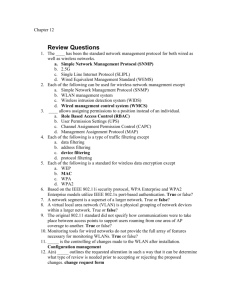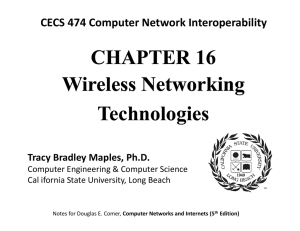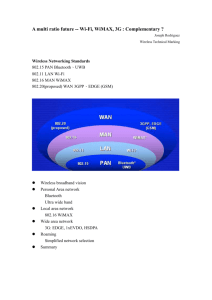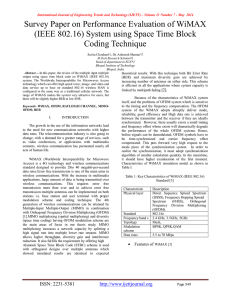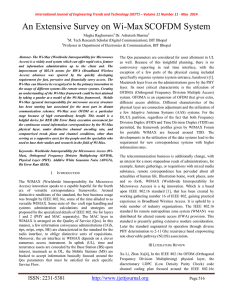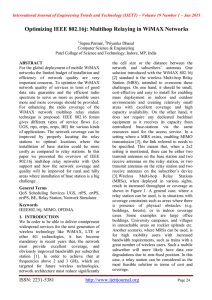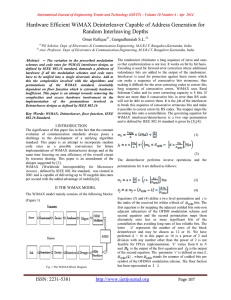Review Questions
advertisement
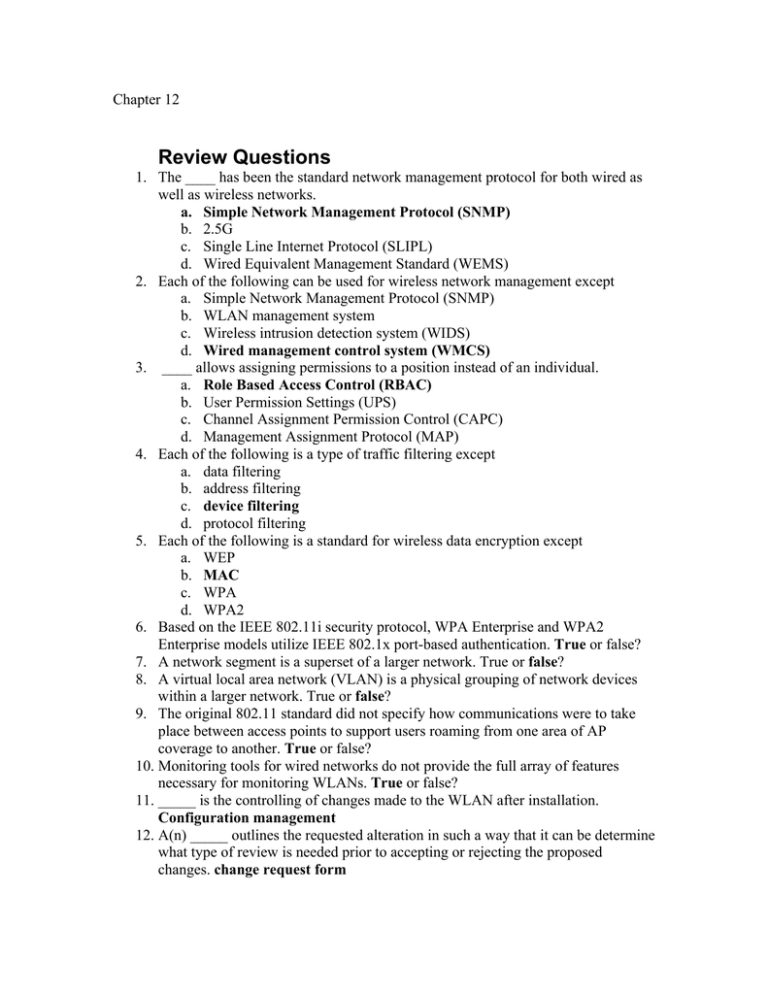
Chapter 12 Review Questions 1. The ____ has been the standard network management protocol for both wired as well as wireless networks. a. Simple Network Management Protocol (SNMP) b. 2.5G c. Single Line Internet Protocol (SLIPL) d. Wired Equivalent Management Standard (WEMS) 2. Each of the following can be used for wireless network management except a. Simple Network Management Protocol (SNMP) b. WLAN management system c. Wireless intrusion detection system (WIDS) d. Wired management control system (WMCS) 3. ____ allows assigning permissions to a position instead of an individual. a. Role Based Access Control (RBAC) b. User Permission Settings (UPS) c. Channel Assignment Permission Control (CAPC) d. Management Assignment Protocol (MAP) 4. Each of the following is a type of traffic filtering except a. data filtering b. address filtering c. device filtering d. protocol filtering 5. Each of the following is a standard for wireless data encryption except a. WEP b. MAC c. WPA d. WPA2 6. Based on the IEEE 802.11i security protocol, WPA Enterprise and WPA2 Enterprise models utilize IEEE 802.1x port-based authentication. True or false? 7. A network segment is a superset of a larger network. True or false? 8. A virtual local area network (VLAN) is a physical grouping of network devices within a larger network. True or false? 9. The original 802.11 standard did not specify how communications were to take place between access points to support users roaming from one area of AP coverage to another. True or false? 10. Monitoring tools for wired networks do not provide the full array of features necessary for monitoring WLANs. True or false? 11. _____ is the controlling of changes made to the WLAN after installation. Configuration management 12. A(n) _____ outlines the requested alteration in such a way that it can be determine what type of review is needed prior to accepting or rejecting the proposed changes. change request form 13. A(n) _____provides the standard for the operation of network against which any changes must be compared. WLAN baseline. 14. A(n) _____ is a listing of all installed wireless components, configuration settings, and diagrams that document the current state of the wireless LAN. configuration management database 15. The current 802.16 standard, known as _____, provides up to 50 kilometers (31 miles) of linear service area range and is not line-of-sight. Fixed WiMAX 16. Explain how the media access control (MAC) layer of WiMax is different from wireless or wired networks. The media access control (MAC) layer of WiMAX is different than that used in IEEE 802.11a/b/g (CSMA/CA) or IEEE 802.2 (CSMA/CD). Instead, WiMAX uses a scheduling system and the device only has to compete once in its initial entry into the network. Once the device has been accepted it is allocated a time slot. Although this time slot can enlarge and shrink, it remains assigned to that device and other devices must take their turn. This type of scheduling algorithm is more stable under heavy loads and is more efficient with bandwidth. The scheduling algorithm also allows the base station to control Quality of Service (QoS) by balancing the assignments among the needs of the subscriber stations 17. What is the last mile connectioin? The last mile connection refers to the connection that begins at a fast Internet service provider, goes through the local neighborhood, and ends at the home or office. Whereas the connections that make up the nation’s data transmission infrastructure are very fast and well established, the last mile connection that links these high-speed transmission lines to the home or office are much slower and not universally available. These slow last mile connections are bottlenecks for users. 18. How is Mobile WiMAX different from Fixed WiMAX? Mobile WiMAX adds mobility components to the standard, allowing users to freely roam both indoors and outdoors for kilometers while remaining connected. Fixed WiMAX provides up to 50 kilometers (31 miles) of linear service area range and is not line-of-sight. WiMAX also provides shared data rates up to 70 Mbps. 19. What are the advantages of Third Generation (3G) cellular telephony networks? Today the three leading wireless carriers in the U.S. are all in the process of rolling out Third Generation (3G) networks. 2.5G was suitable for wireless e-mail and some customized products that. With throughput rates for 3G averaging between 400Kbps to 700Kbps, this means for the first time the cellular telephone network can be used for wireless data communications. A laptop computer with a PC card and a virtual private network (VPN) client will allow mobile workers to access remote networks wherever there is cellular coverage. 20. Explain how WiMax could replace 3G and WLANs for wide area network data transmissions. Mobile WiMAX in the long run may replace IEEE 802.11and 3G cellular data service for wireless area coverage in the wide area. Because IEEE 802.20 supports both fixed as well as mobile clients, this single technology has the potential to ultimately replace 3G cellular data service as well as WLAN. These technologies would then be found in more specialized applications. For example, IEEE 802.11 will be used indoors while 3G will only be used in rural areas where no other coverage exists.
